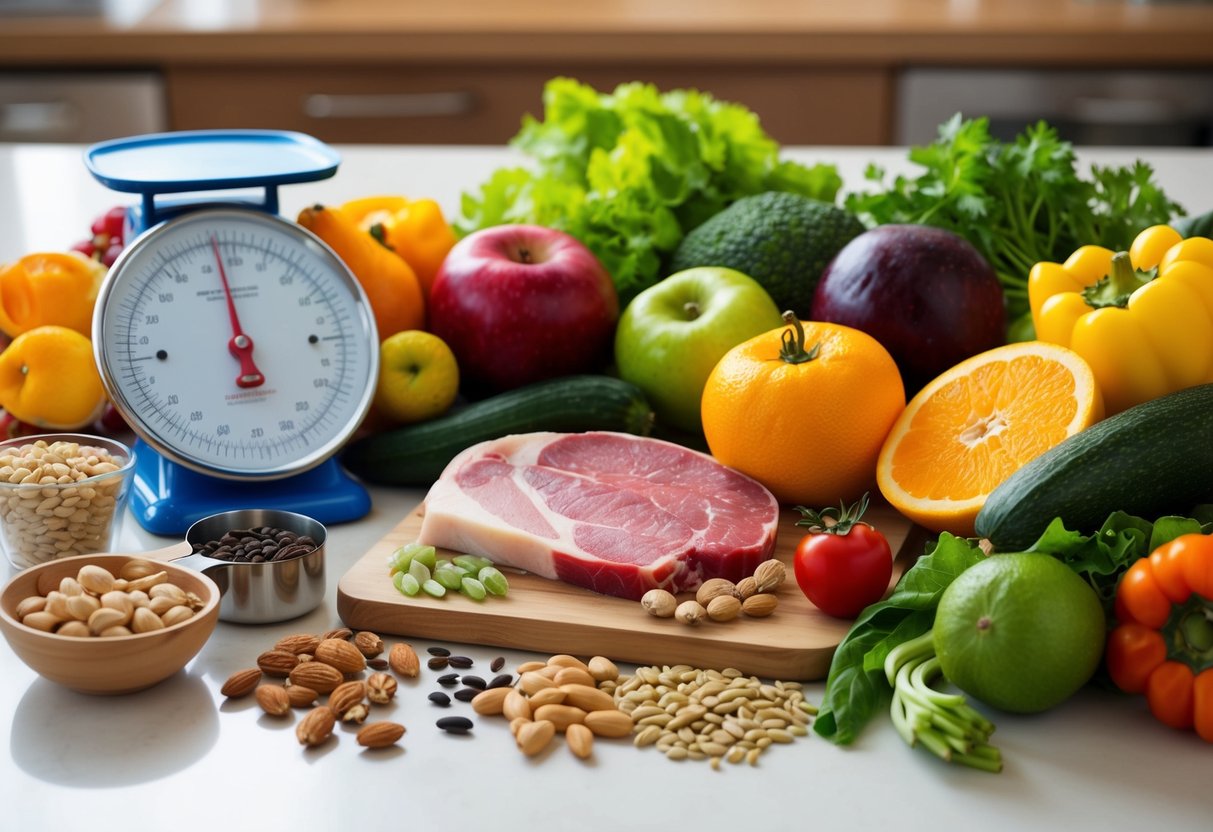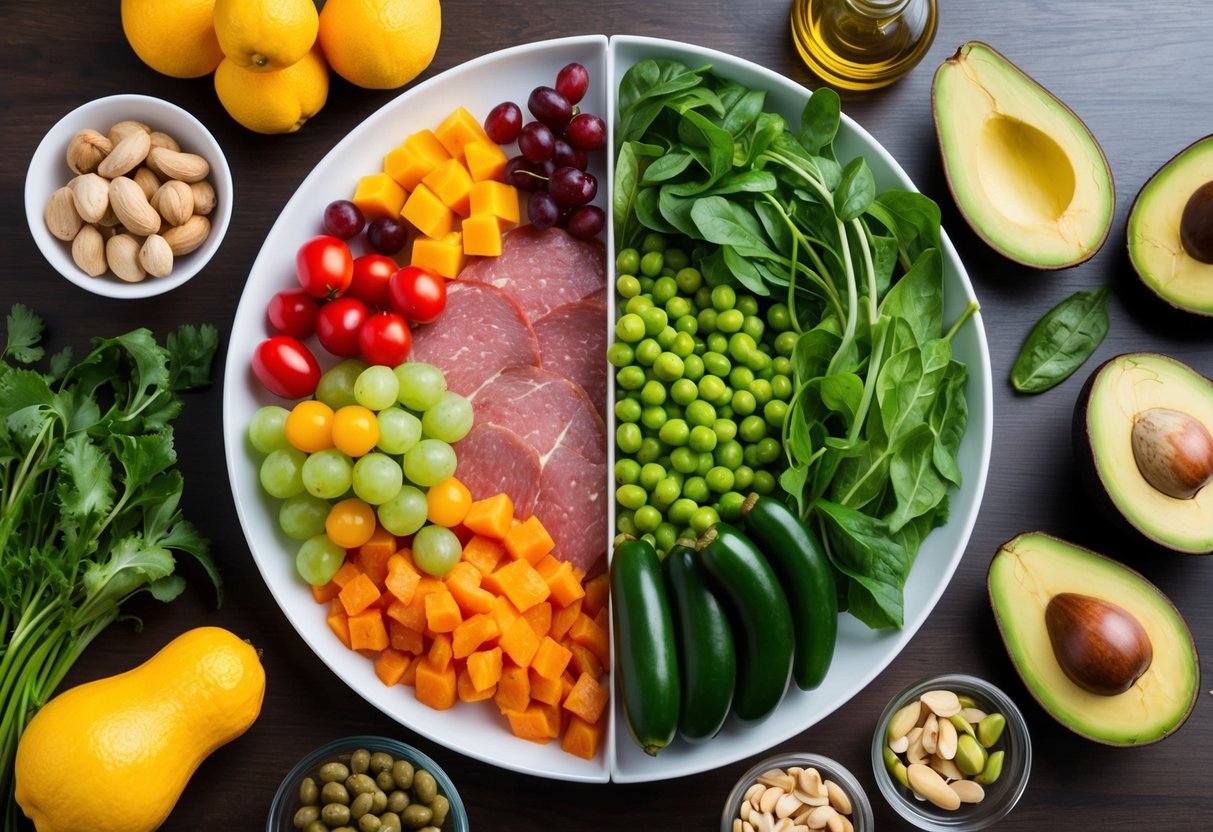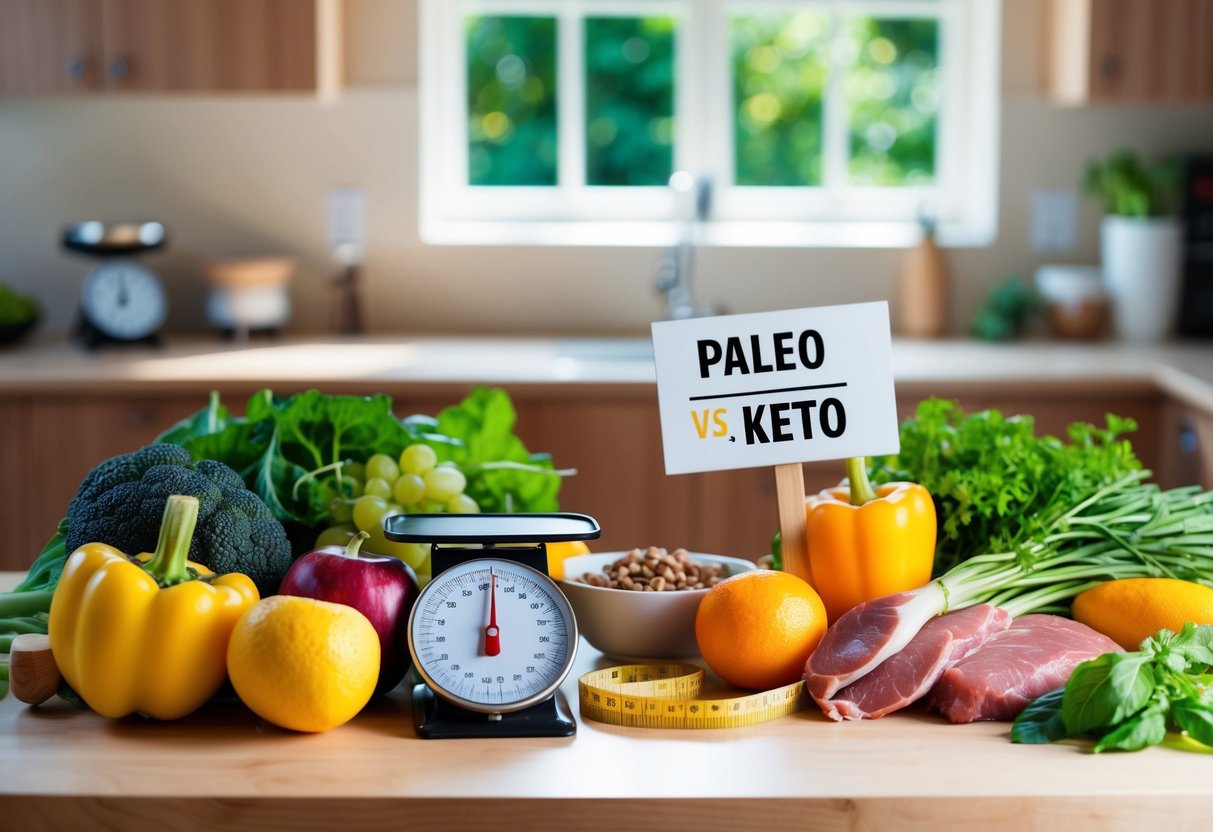Paleo vs Keto: Comparing Diet Benefits and Challenges
This post may contain affiliate links. If you purchase through these links, I may earn a small commission at no extra cost to you. LEARN MORE.
Choosing between the Paleo and Keto diets can be challenging, but understanding their core differences is key.
Both diets emphasize whole foods and eliminating processed items, yet they diverge in their approach to macros and food choices.
The Keto diet focuses on high fat and low carbohydrate intake to induce ketosis, while Paleo emphasizes eating foods presumed to be available to our ancient ancestors, like lean meats and vegetables.

For those considering weight loss or improved health, knowing the pros and cons of each can guide the decision-making process.
While the Keto diet may lead to faster weight loss due to ketosis, it can be harder to maintain long-term.
On the other hand, the Paleo diet offers more dietary variety, potentially leading to easier adherence over time.
Each person’s lifestyle and goals play a crucial role in determining which diet might be more suitable.
Key Takeaways
- Keto emphasizes high fat and low carbs for ketosis.
- Paleo focuses on whole foods similar to ancient diets.
- Consider lifestyle and goals to choose the best diet.
Understanding Paleo and Keto Diets

The Paleo and Keto diets have garnered significant attention for their distinct approaches to nutrition and wellness. Both diets emphasize the importance of whole foods and restrict certain types of foods, though their principles and focuses differ.
Principles of the Paleo Diet
The Paleo diet, often called the “caveman diet,” aims to mimic the eating habits of our ancestors. It prioritizes whole foods such as lean meats, fish, fruits, and vegetables.
Processed foods, grains, legumes, and dairy are largely excluded.
This diet supports consuming natural, unprocessed foods believed to align with human evolutionary adaptability. By emphasizing nutrient-dense foods, it aims to improve health.
Principles of the Keto Diet
The Keto diet centers on a high-fat, moderate-protein, and low-carbohydrate intake. The goal is to enter a state of ketosis, where the body uses fat as its primary energy source rather than carbohydrates.
Typical foods include meats, fish, eggs, dairy, nuts, and low-carb vegetables.
By drastically reducing carbohydrate intake, the ketogenic diet aims to promote rapid weight loss and better blood sugar control.
A Comparison of Paleo and Keto Macro-nutrient Breakdown
When comparing macronutrient breakdowns, the Paleo diet offers more flexibility. It does not specify macronutrient ratios, focusing instead on whole and unprocessed foods.
In contrast, the Keto diet has a strict macronutrient ratio, usually around 70% fat, 25% protein, and 5% carbohydrates.
This strict adherence is crucial for maintaining ketosis, thus distinguishing it from Paleo’s more flexible guidelines.
Scientific Evidence Behind Paleo and Keto
Scientific studies have explored the health impacts of both diets.
Research suggests that the Keto diet may support weight loss and blood sugar control due to its ketogenic state. Studies have also looked into cognitive benefits and its potential to manage certain health conditions.
The Paleo diet is often associated with better metabolic health and reduced inflammation. However, long-term conclusive evidence is limited for both diets, necessitating further research for comprehensive health assessments.
Pros and Cons of Both Diets

The Paleo and Keto diets each offer unique benefits and drawbacks that might suit different dietary goals and preferences.
While both emphasize reducing processed foods and focus on whole foods, they differ in their approach to carbohydrates and fats.
Pros and Cons of Paleo Diet
The Paleo diet focuses on consuming whole foods like vegetables, fruits, meats, nuts, and seeds, while excluding grains, dairy, legumes, and refined sugar.
Pros of this diet include improved gut health and potential for weight loss through consumption of nutrient-dense foods. Its emphasis on unprocessed foods may enhance mental clarity and blood sugar control.
Cons include difficulty in maintaining diet adherence due to restrictions on grains and legumes, which can be significant sources of fiber.
Additionally, eliminating dairy and grains might lead to nutrient deficiencies if not properly planned. Those with specific athletic goals might find it challenging to meet energy needs without grains and legumes.
Pros and Cons of Keto Diet
The Keto diet prioritizes high-fat, low-carbohydrate intake to induce ketosis, where the body burns fat for fuel.
Pros include effective weight loss and potential benefits for type 2 diabetes management. The diet may improve cardiovascular health markers due to the focus on healthy fats, and some individuals report enhanced mental clarity.
Cons include initial side effects such as the “keto flu,” which can include fatigue and nausea as the body adjusts.
There is also a risk of nutrient deficiencies due to limited food variety.
Maintaining this diet can be challenging due to the need to continuously track carbohydrate intake and the exclusion of grains and many fruits.
Individuals with certain neurological disorders might find it beneficial, but they should consult a healthcare professional.
Impact on Diet Sustainability and Lifestyle

When choosing between the Paleo and Keto diets, it is crucial to consider factors like cost, accessibility, sustainability, and the influence on physical and mental aspects of lifestyle. Each diet has distinct impacts on these areas.
Considering the Cost and Accessibility of Both Diets
Costs and accessibility play a significant role in diet sustainability.
The Paleo diet typically emphasizes fresh produce, meats, and organic foods, which can be expensive and may not be readily available in every location.
Meanwhile, the Keto diet often involves higher costs due to the need for specific fats like avocados, nuts, and oils.
Both diets require careful planning and budgeting, but accessing specific keto items may require more effort, especially in regions where they are not mainstream.
Evaluating Long-term Sustainability
Sustainability is an essential aspect of any diet.
The Paleo diet can be easier to maintain over time for many individuals, primarily because it allows for a wider variety of foods and fewer restrictions compared to keto.
Keto’s strict carbohydrate limits can lead to diet fatigue over time.
Long-term research on both diets suggests mindfulness and careful planning are necessary to avoid deficits and ensure a nutritionally complete intake.
Individuals should consider how each diet fits into their lifestyle and adherence capabilities over the long term.
Diet’s Influences on Exercise and Mental Focus
Diet can significantly influence exercise performance and mental clarity.
The Keto diet is known for enabling fat adaptation, which may enhance endurance in certain types of exercise. However, it can initially lead to decreased performance while the body adjusts.
In contrast, the Paleo diet supports various types of physical activity due to its balanced macronutrient intake.
Mental focus may be sharpened on keto due to the brain’s use of ketones, but some experience challenges with concentration initially.
Both diets require individuals to monitor their body’s response to optimize physical and mental outcomes effectively.
Foods to Eat and Avoid on Paleo and Keto Diets

The Paleo and Keto diets both emphasize whole, natural foods, yet they each have unique elements. Understanding what foods are specific to either diet, as well as those that overlap, provides clarity for individuals choosing between them.
Foods Exclusive to Paleo Diet
The Paleo diet encourages eating foods believed to be consumed by early humans. Emphasis is placed on meat, fish, fruits, vegetables, nuts, and seeds. Certain oils like olive oil and avocado oil are recommended.
Paleo strictly avoids all grains, legumes, and processed sugar. Natural sweeteners such as raw honey, coconut sugar, and maple syrup are allowed in moderation.
Dairy is typically not part of the Paleo diet due to its absence in hunter-gatherer food practices.
Foods Exclusive to Keto Diet
The Keto diet focuses on high-fat, low-carb intake to achieve ketosis. Healthy fats are a staple, including butter, lard, tallow, coconut oil, and ghee.
Low-carb vegetables are favored, while most fruits are avoided due to higher sugar content.
Unlike Paleo, specific savory dairy products such as cheese and cream are allowed because they are low in carbohydrates.
Sugars and grains are strictly eliminated to maintain low carb levels.
Cross-Over Foods in Both Diets
Both diets promote meat, fish, vegetables, and eggs. These staples are complemented by healthy oils like olive oil and avocado oil.
Nuts and seeds are also encouraged in moderation, offering essential nutrients without excess carbohydrates.
Both avoid processed foods and refined sugars, advocating for more natural sweeteners with careful moderation in Keto.
Which Diet is Best for You? Find Out Here!

Determining whether the Paleo or Keto diet is the best fit involves examining individual health goals, lifestyle preferences, and any specific dietary needs. Understanding these factors can guide the decision-making process toward one of these popular diets.
Consulting with a Registered Dietitian
A registered dietitian can provide valuable guidance tailored to individual needs, helping to navigate dietary restrictions and ensuring nutritional balance.
They assess macronutrient focus, advising on appropriate fat and carb intake that align with weight management or overall health goals.
These professionals offer insights into how each diet might affect blood sugar control, digestive health, and appetite suppression.
Consulting with a dietitian is particularly important for those with specific health concerns or nutritional deficiencies, ensuring a diet plan that accommodates unique circumstances.
Assessing Personal Health Goals and Preferences
Understanding personal health goals and preferences is critical when choosing between Paleo and Keto.
The primary goal could be fat loss, muscle gain, or improved health benefits like reduced inflammation.
The Keto diet may appeal to those focusing on high fat intake and low carb consumption for fat loss and appetite suppression.
Meanwhile, Paleo emphasizes food quality and ancestral eating, offering flexibility with unprocessed and natural foods.
Balancing these factors with personal preferences helps in making a well-informed decision.
Considering Dietary Restrictions and Food Sensitivities
Both diets can be adapted to accommodate various dietary restrictions and food sensitivities.
Paleo avoids processed foods, emphasizing whole foods and steering clear of soy products, while Keto requires tracking specific macronutrients like fats and oils.
Individuals with food sensitivities might find Paleo more suitable due to its focus on natural ingredients.
This focus can potentially benefit those with digestive health concerns. Understanding allergies or food sensitivities ensures a diet plan that enhances overall well-being without discomfort.
Frequently Asked Questions
The Paleo and Keto diets both offer different approaches to nutrition, often focusing on specific food groups to achieve distinct health benefits.
Each diet has its own unique effects on weight management, blood sugar control, and inflammation reduction.
What are the primary differences between the Paleo and Keto diets?
The Paleo diet emphasizes whole foods and excludes processed foods, grains, and dairy, focusing on lean meats, fruits, and vegetables.
Keto is centered around high-fat, low-carb intake to induce ketosis, a metabolic state that burns fat for energy. This fundamental distinction in macronutrient focus separates the two diets.
Can both Paleo and Keto diets help with weight loss, and if so, which is generally considered more effective?
Both diets can support weight loss.
Paleo relies on nutrient-dense foods to manage hunger. Keto promotes quick fat loss through carb restriction and maintaining ketosis. The effectiveness may vary individually depending on adherence and specific metabolic responses.
How does each diet, Paleo and Keto, affect individuals with diabetes?
Both diets can aid blood sugar management.
Paleo eliminates refined carbs and promotes a stable blood sugar level. Keto significantly reduces carbohydrates, which can improve insulin sensitivity. Individuals should consult healthcare professionals to tailor these diets to their diabetic needs.
Which diet is associated with better outcomes for reducing inflammation?
Paleo is often linked with reduced inflammation due to its emphasis on whole foods and exclusion of processed sugars and grains.
Keto might also aid in reducing inflammation through ketone production, which has anti-inflammatory properties, though evidence is not as robust as for Paleo.
Are there any long-term health risks associated with following a Paleo or Keto diet?
Long-term health risks of Paleo might include potential nutrient deficiencies from excluding certain food groups.
Keto could lead to issues such as kidney strain and lipid imbalances due to its high-fat content. Long-term adherence should be monitored by a healthcare professional.
How do Paleo and Keto diets compare when it comes to managing and reducing belly fat?
Keto is often praised for its effectiveness in targeting belly fat through the process of ketosis, promoting fat as a primary energy source.
Paleo, with its balanced nutrient intake, can also help reduce waist circumference, but results may not be as rapid as keto.





